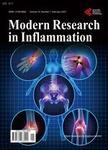Effects of Light Emitting Diode in Erythrocytes
发光二极管的红细胞中的作用作者机构:Universidade Federal do Rio Grande do Norte(UFRN)NatalBrazil Universidade Federal do Rio de Janeiro(UFRJ)Rio de JaneiroBrazil Universidade Estadual do Rio de Janeiro(UERJ)Rio de JaneiroBrazil Instituto CelulareCentro de Tratamento a Laser e Terapia CelularRio de JaneiroBrazil
出 版 物:《Modern Research in Inflammation》 (炎症(英文))
年 卷 期:2014年第3卷第3期
页 面:122-127页
学科分类:1002[医学-临床医学] 100214[医学-肿瘤学] 10[医学]
主 题:LED Blood Spectrophotometer
摘 要:The Light Emitting Diode (LED) is a phototherapy equipment, poorly studied, which is able of acting on blood level and it has frequently appeared in clinical practice of physiotherapy to aid on skin rejuvenation, control inflammation and wound healing. The aim of the study was to evaluate the effects of LED on red blood cells through the spectrophotometer. This is an experimental study with a sample of 5 male Wistar rats weighting between 200 g and 350 g, randomly selected, anesthetized and 4 ml of blood was collected by cardiac puncture. The blood collected was divided into four groups, one control and three treated, these individually irradiated by blue LED (420 - 490 nm), green LED (515 - 570 nm) and red LED (620 - 680 nm) at an output of 3 watts, for 10 minutes and 5 cm apart from the surface of the blood, then it was analyzed by a spectrophotometer at 540 nm. The results were submitted to Anova and Post-roch Turkey (p 0.05). All wavelengths tested produced hemolysis greater than the control in hypotonic solutions of NaCl (range 0.02 to 0.06 M) (p 0.01). Only the band between 515 - 570 nm provides a higher hemolysis (range 0.06 to 0.1) when compared to the control group (p 0.05). The irradiation of blood through the LED therapy was able to weaken the cell membrane of the red blood cells. It is likely that hemolysis does not bring harm the body, because as it is a local therapy, the amount of hemolysis that can be caused is small and it will induce the reproduction of new red blood cells, thus improving their physiological functions.



